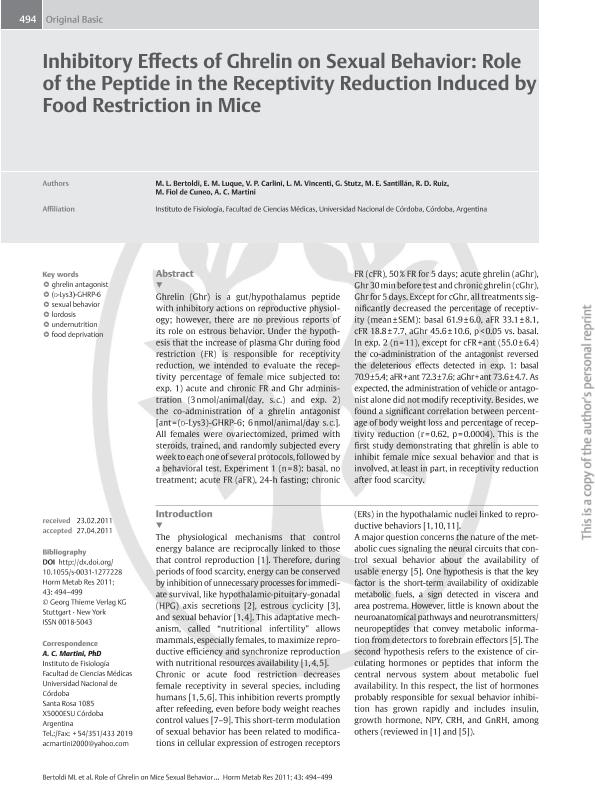Mostrar el registro sencillo del ítem
dc.contributor.author
Bertoldi, María Laura

dc.contributor.author
Luque, E. M.
dc.contributor.author
Carlini, Valeria Paola

dc.contributor.author
Vincenti, Laura María

dc.contributor.author
Stutz, Graciela

dc.contributor.author
Santillán, M.E.
dc.contributor.author
Ruiz, R. D.
dc.contributor.author
Fiol de Cuneo, Marta
dc.contributor.author
Martini, Ana Carolina

dc.date.available
2024-03-18T17:14:41Z
dc.date.issued
2011-04
dc.identifier.citation
Bertoldi, María Laura; Luque, E. M.; Carlini, Valeria Paola; Vincenti, Laura María; Stutz, Graciela; et al.; Inhibitory effects of ghrelin on sexual behavior: Role of the peptide in the receptivity reduction induced by food restriction in mice; Georg Thieme Verlagiaorl@iaorl.org; Hormone and Metabolic Research; 43; 7; 4-2011; 494-499
dc.identifier.issn
0018-5043
dc.identifier.uri
http://hdl.handle.net/11336/230825
dc.description.abstract
Ghrelin (Ghr) is a gut/hypothalamus peptide with inhibitory actions on reproductive physiology; however, there are no previous reports of its role on estrous behavior. Under the hypothesis that the increase of plasma Ghr during food restriction (FR) is responsible for receptivity reduction, we intended to evaluate the receptivity percentage of female mice subjected to: exp. 1) acute and chronic FR and Ghr administration (3 nmol/animal/day, s. c.) and exp. 2) the co-administration of a ghrelin antagonist [ant=(d-Lys3)-GHRP-6; 6 nmol/animal/day s. c.]. All females were ovariectomized, primed with steroids, trained, and randomly subjected every week to each one of several protocols, followed by a behavioral test. Experiment 1 (n=8): basal, no treatment; acute FR (aFR), 24-h fasting; chronic FR (cFR), 50% FR for 5 days; acute ghrelin (aGhr), Ghr 30 min before test and chronic ghrelin (cGhr), Ghr for 5 days. Except for cGhr, all treatments significantly decreased the percentage of receptivity (mean±SEM): basal 61.9±6.0, aFR 33.1±8.1, cFR 18.8±7.7, aGhr 45.6±10.6, p<0.05 vs. basal. In exp. 2 (n=11), except for cFR+ant (55.0±6.4) the co-administration of the antagonist reversed the deleterious effects detected in exp. 1: basal 70.9±5.4; aFR+ant 72.3±7.6; aGhr+ant 73.6±4.7. As expected, the administration of vehicle or antagonist alone did not modify receptivity. Besides, we found a significant correlation between percentage of body weight loss and percentage of receptivity reduction (r=0.62, p=0.0004). This is the first study demonstrating that ghrelin is able to inhibit female mice sexual behavior and that is involved, at least in part, in receptivity reduction after food scarcity.
dc.format
application/pdf
dc.language.iso
eng
dc.publisher
Georg Thieme Verlagiaorl@iaorl.org

dc.rights
info:eu-repo/semantics/openAccess
dc.rights.uri
https://creativecommons.org/licenses/by-nc-sa/2.5/ar/
dc.subject
GRHELIN ANTAGONIST
dc.subject
(D-LYS3)-GHRP6
dc.subject
SEXUAL BEHAVIOR
dc.subject.classification
Biología Reproductiva

dc.subject.classification
Ciencias Biológicas

dc.subject.classification
CIENCIAS NATURALES Y EXACTAS

dc.title
Inhibitory effects of ghrelin on sexual behavior: Role of the peptide in the receptivity reduction induced by food restriction in mice
dc.type
info:eu-repo/semantics/article
dc.type
info:ar-repo/semantics/artículo
dc.type
info:eu-repo/semantics/publishedVersion
dc.date.updated
2024-03-05T13:19:22Z
dc.identifier.eissn
1439-4286
dc.journal.volume
43
dc.journal.number
7
dc.journal.pagination
494-499
dc.journal.pais
Alemania

dc.description.fil
Fil: Bertoldi, María Laura. Consejo Nacional de Investigaciones Científicas y Técnicas. Centro Científico Tecnológico Conicet - Córdoba. Centro de Investigaciones en Química Biológica de Córdoba. Universidad Nacional de Córdoba. Facultad de Ciencias Químicas. Centro de Investigaciones en Química Biológica de Córdoba; Argentina
dc.description.fil
Fil: Luque, E. M.. Universidad Nacional de Cordoba. Facultad de Ciencias Medicas. Instituto de Fisiologia Profesor Oscar Orias;
dc.description.fil
Fil: Carlini, Valeria Paola. Consejo Nacional de Investigaciones Científicas y Técnicas. Centro Científico Tecnológico Conicet - Córdoba. Instituto de Investigaciones en Ciencias de la Salud. Universidad Nacional de Córdoba. Instituto de Investigaciones en Ciencias de la Salud; Argentina
dc.description.fil
Fil: Vincenti, Laura María. Universidad Nacional de Cordoba. Facultad de Ciencias Medicas. Instituto de Fisiologia Profesor Oscar Orias;
dc.description.fil
Fil: Stutz, Graciela. Universidad Nacional de Cordoba. Facultad de Ciencias Medicas. Instituto de Fisiologia Profesor Oscar Orias;
dc.description.fil
Fil: Santillán, M.E.. Universidad Nacional de Cordoba. Facultad de Ciencias Medicas. Instituto de Fisiologia Profesor Oscar Orias;
dc.description.fil
Fil: Ruiz, R. D.. Universidad Nacional de Cordoba. Facultad de Ciencias Medicas. Instituto de Fisiologia Profesor Oscar Orias;
dc.description.fil
Fil: Fiol de Cuneo, Marta. Universidad Nacional de Cordoba. Facultad de Ciencias Medicas. Instituto de Fisiologia Profesor Oscar Orias;
dc.description.fil
Fil: Martini, Ana Carolina. Consejo Nacional de Investigaciones Científicas y Técnicas. Centro Científico Tecnológico Conicet - Córdoba. Instituto de Investigaciones en Ciencias de la Salud. Universidad Nacional de Córdoba. Instituto de Investigaciones en Ciencias de la Salud; Argentina
dc.journal.title
Hormone and Metabolic Research

dc.relation.alternativeid
info:eu-repo/semantics/altIdentifier/url/https://www.thieme-connect.com/DOI/DOI?10.1055/s-0031-1277228
dc.relation.alternativeid
info:eu-repo/semantics/altIdentifier/doi/http://dx.doi.org/10.1055/s-0031-1277228
Archivos asociados
